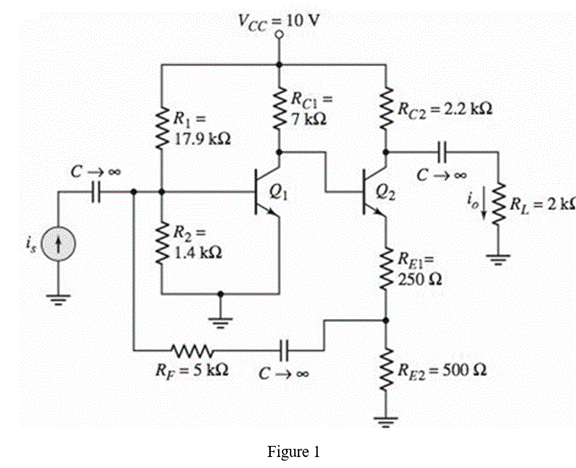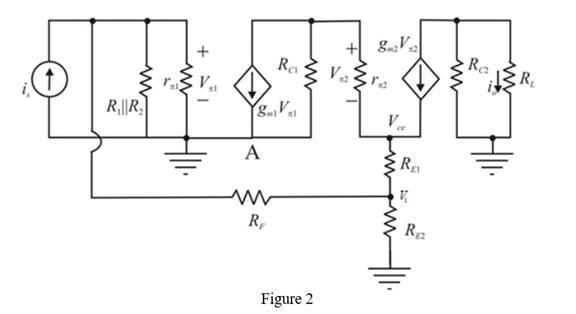
For the transistors in the circuit in Figure P 12.53, the parameters are:

The value of the closed loop current gain of the circuit.
Answer to Problem 12.53P
The value of the current gain is
Explanation of Solution
Given:
The given diagram is shown in Figure 1

Calculation:
The small signal model of the above circuit is shown below.
The required diagram is shown in Figure 2

The expression to determine the value of the Thevenin resistance of the circuit is given by,
The Thevenin voltage of the circuit is calculated as,
The expression for the base current of the first transistor is given by,
Substitute
The expression to determine the collector current of the first transistor is given by,
Substitute
The expression to determine the value of the base voltage of the second transistor is given by,
Substitute
The expression for the current
Substitute
The expression to determine the value of the collector current
Substitute
The expression for the transconductance of the first transistor is given by,
Substitute
The expression for the small signal resistance is given by,
Substitute
The expression for the transconductance of the second transistor is given by,
Substitute
The expression for the small signal resistance is given by,
Substitute
Apply KCL at source
Substitute
Apply KCL at node A.
Substitute
Apply KCL at node
Substitute
Apply KCL at
Substitute
Substitute
Substitute
Substitute
Substitute
The expression to determine the value of the output current is given by,
Substitute and
Substitute
Conclusion:
Therefore, the value of the current gain is
Want to see more full solutions like this?
Chapter 12 Solutions
Microelectronics: Circuit Analysis and Design
- Discuss the difference between the current series negative feedback amplifier and voltage shunt feedback amplifier in terms of output impedance, input impedance, voltage gain, bandwidth, distortion and noise.arrow_forwardFind the range of K using the Routh - Hurwitz method for the closed - loop stability of the negative unit feedback system given the open - loop transition function belowarrow_forwarddescribe the expression of sensitivity of C.L.T.F. wrt. feedback gain.arrow_forward
- Determine,if it exists,a state feedback gain K such that the closed loop poles are located at −5 and −6.arrow_forwardA unity feedback system with open-loop transfer function given as:?(?) = ??. ?(? + ?)(? + ?)(? + ??)without affecting its operating point (−1.54 ∓ ??2.66) appreciably a- Design a suitable compensator to drive the step response error to zero.b- Design a suitable compensator to reduce step error by factor of 5.arrow_forwardThe input-output transfer function of the system shown in Figure 1 is used with the help of Mason gain formulation. specifyarrow_forward
 Introductory Circuit Analysis (13th Edition)Electrical EngineeringISBN:9780133923605Author:Robert L. BoylestadPublisher:PEARSON
Introductory Circuit Analysis (13th Edition)Electrical EngineeringISBN:9780133923605Author:Robert L. BoylestadPublisher:PEARSON Delmar's Standard Textbook Of ElectricityElectrical EngineeringISBN:9781337900348Author:Stephen L. HermanPublisher:Cengage Learning
Delmar's Standard Textbook Of ElectricityElectrical EngineeringISBN:9781337900348Author:Stephen L. HermanPublisher:Cengage Learning Programmable Logic ControllersElectrical EngineeringISBN:9780073373843Author:Frank D. PetruzellaPublisher:McGraw-Hill Education
Programmable Logic ControllersElectrical EngineeringISBN:9780073373843Author:Frank D. PetruzellaPublisher:McGraw-Hill Education Fundamentals of Electric CircuitsElectrical EngineeringISBN:9780078028229Author:Charles K Alexander, Matthew SadikuPublisher:McGraw-Hill Education
Fundamentals of Electric CircuitsElectrical EngineeringISBN:9780078028229Author:Charles K Alexander, Matthew SadikuPublisher:McGraw-Hill Education Electric Circuits. (11th Edition)Electrical EngineeringISBN:9780134746968Author:James W. Nilsson, Susan RiedelPublisher:PEARSON
Electric Circuits. (11th Edition)Electrical EngineeringISBN:9780134746968Author:James W. Nilsson, Susan RiedelPublisher:PEARSON Engineering ElectromagneticsElectrical EngineeringISBN:9780078028151Author:Hayt, William H. (william Hart), Jr, BUCK, John A.Publisher:Mcgraw-hill Education,
Engineering ElectromagneticsElectrical EngineeringISBN:9780078028151Author:Hayt, William H. (william Hart), Jr, BUCK, John A.Publisher:Mcgraw-hill Education,





